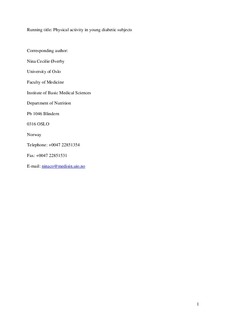| dc.contributor.author | Øverby, Nina Cecilie | |
| dc.contributor.author | Margeirsdottir, Hanna D. | |
| dc.contributor.author | Brunborg, Cathrine | |
| dc.contributor.author | Anderssen, Sigmund A. | |
| dc.contributor.author | Andersen, Lene F. | |
| dc.contributor.author | Dahl-Jørgensen, Knut | |
| dc.date.accessioned | 2010-03-04T10:10:58Z | |
| dc.date.issued | 2008-08-20 | |
| dc.identifier | Seksjon for idrettsmedisinske fag / Department of Sports Medicine | |
| dc.identifier.citation | Pediatric Diabetes. 2009, 10(2), 135-141 | en |
| dc.identifier.issn | 1399-543X | |
| dc.identifier.uri | http://hdl.handle.net/11250/170595 | |
| dc.description | I Brage finner du siste tekst-versjon av artikkelen, og den kan inneholde ubetydelige forskjeller fra forlagets pdf-versjon. Forlagets pdf-versjon finner du på www.interscience.wiley.com: http://dx.doi.org/10.1111/j.1399-5448.2008.00454.x / In Brage you'll find the final text version of the article, and it may contain insignificant differences from the journal's pdf version. The original publication is available at www.interscience.wiley.com: http://dx.doi.org/10.1111/j.1399-5448.2008.00454.x | en |
| dc.description.abstract | Aim: To describe physical activity and inactivity and parameters associated with overweight in a population-based study of children and adolescents on intensive insulin treatment.
Methods: Physical activity and inactivity were evaluated in 723 type 1 diabetic subjects, 240 children aged 6–10 yr and 483 adolescents aged 11–19 yr, using a questionnaire that can estimate total amount of time spent on inactivity and light, moderate and vigorous activity.
Results: Overall, 54% of the participants do not fulfil the international recommendations of 60 min of moderate-to-vigorous activity per day. Girls are less active than boys in childhood (70 vs. 88 min/d, p = 0.01) and in adolescence (47 vs. 57 min/d, p = 0.02). Furthermore, this study shows that those who are more active are also those who seldom skip meals (p < 0.001). Forty-three percent of the participants watch TV for more than 2 h a day, and TV viewing was found to be related to overweight in children and adolescents with type 1 diabetes [OR: 2.5 (1.40–4.54), p = 0.002]. No statistical differences in physical activity were noted between the different intensified insulin regimens. Patients wearing insulin pumps were not less active.
Conclusion: To increase physical activity to recommended level and limit TV viewing should be an important issue in education of all children and adolescents with type 1 diabetes, independent of insulin regimen. | en |
| dc.format.extent | 51716 bytes | |
| dc.format.mimetype | application/pdf | |
| dc.language.iso | eng | en |
| dc.publisher | Wiley | en |
| dc.subject | childhood diabetes | en |
| dc.subject | overweight | en |
| dc.subject | physical activity | en |
| dc.title | Physical activity and overweight in children and adolescents using intensified insulin treatment | en |
| dc.type | Peer reviewed | en |
| dc.type | Journal article | en |
| dc.subject.nsi | VDP::Medical disciplines: 700 | en |
| dc.source.pagenumber | 135-141 | en |
| dc.source.volume | 10 | en |
| dc.source.journal | Pediatric Diabetes | en |
| dc.source.issue | 2 | en |
